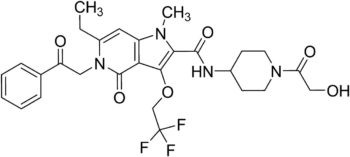
| 规格 | 价格 | 库存 | 数量 |
|---|---|---|---|
| 5mg |
|
||
| 10mg |
|
||
| 25mg |
|
||
| 50mg |
|
||
| Other Sizes |
|
| 体外研究 (In Vitro) |
TAK-441(化合物 11d)(0.03–1000 nM,48 h)在 Gli-luc 报告基因中表现出良好的溶解度和较强的活性,IC50 值为 4.4 nM[1]。 TAK-441(0.03-1000 nM,48 h)抑制 Gli1 mRNA,在肿瘤和皮肤中的 IC50 值分别为 0.0457 和 0.113 mg/ml[1]。雄激素撤退诱导的 Shh 上调不受 TAK-441(0.5-500 nM,48-72 小时)的影响。然而,通过干扰肿瘤基质的旁分泌 Hh 信号传导,TAK-441(0.5-500 nM,48-72 小时)会导致 LNCaP 异种移植物进展更慢,对去势产生抵抗[3]。
|
|---|---|
| 体内研究 (In Vivo) |
在 BALB/c-nu/nu 小鼠中,TAK-441(化合物 11d)(口服;10 mg/kg、100 mg/kg)表现出良好的暴露和良好的口服吸收[1]。 TAK-441(口服,1 和 25 mg/kg,每日一次,持续 14 天)表现出强大的抗癌功效,可通过增加 TAK-441 在 Ptc1+/-p53-/- 小鼠中的溶解度来产生剂量依赖性血浆和肿瘤浓度接受髓母细胞瘤同种异体移植[1]。口服给药后,TAK-441(静脉注射,1 mg/kg;口服,10 mg/kg)可在大鼠和狗中产生足够的暴露量[1]。在异种移植小鼠中,TAK-441(口服;1、10 和 25 mg/kg)具有剂量依赖性抗癌功效;抑制肿瘤发展的IC50值为0.075 mg/ml[1]。 BALB/c-nu/nu 小鼠口服和通过 Alzet 输注(100 mg/kg,单剂量)施用的 TAK-441 的药代动力学参数[1]。 Cmax (lg/mL) AUC (lgh/mL) 化合物 小鼠 PK 10mg/kg 小鼠 PK 100mg/kg Cmax (lg/mL) AUC (lgh/mL) 1 2.65 12.1 3.63 32.3 11d 5.62 28.3 21.5 206
|
| 细胞实验 |
细胞活力测定[1]
细胞类型: NIH3T3/Gli-luc 细胞 测试浓度: 0.03–1000 nM 孵育时间:48小时 实验结果:证明了可接受的溶解度和有效的Hh抑制活性。 细胞毒性测定[3] 细胞类型: LNCaP 细胞 测试浓度: 0.5-500 nM 孵育时间:48-72 h 实验结果:雄激素剥夺条件下不影响LNCaP细胞体外活力Shh的上调。 蛋白质印迹分析[3] 细胞类型: LNCaP、C4-2、DU145 和 PC3 细胞 测试浓度: 孵育持续时间: 实验结果: 反映雄激素反应性 PCa,在 LNCaP 和 C4-2 细胞中表达 Shh 和 Dhh,并反映在 LNCaP 和 C4-2 细胞中限制性表达 CRPC DU145 和 PC3 细胞。 |
| 动物实验 |
Animal/Disease Models: rats and dogs[1]
Doses: 1 mg/kg, 10 mg/kg Route of Administration: iv, 1 mg/kg; po, 10 mg/kg Experimental Results: Compd Mouse PK 10mg/kg Vss(mL/kg ) CL (mL/h/kg) AUC0–24h,iv(ng h/mL) AUC0–24h,po(ng h/mL) F (%) Rat 681.6 ± 81.6 397.9 ± 10.1 2532.3 ± 69.1 8031.8 ± 1218.6 31.7 Dog 2181.3 ± 82.8 161.3 ± 35.6 5101.5 ± 685.5 45405.6 ± 5812.0 90.3 ± 8.8 Animal/Disease Models: BALB/c-nu/nu (nude) mice[1] Doses: 10 mg/kg, 100 mg/kg Route of Administration: oral; 10 mg/kg, 100 mg/kg Experimental Results: Inhibits Gli1 mRNA in the tumor and skin with IC50 values of 0.0457 mg/mL and 0.113 mg/mL, respectively. Animal/Disease Models: Ptc1+/-p53-/- mice[1] Doses: 1 and 25 mg/ kg Route of Administration: po (oral gavage) 1 and 25 mg/kg, QD for 14 days Experimental Results: demonstrated strong antitumor activity and resulted in a dose-dependent PK profile by improving solubility. |
| 参考文献 |
|
| 其他信息 |
Smoothened Antagonist TAK-441 is an orally bioavailable pyrrolopyridine derivative and Smoothened (Smo) antagonist with potential antineoplastic activity. Smo antagonist TAK-441 selectively binds to and inhibits the activity Smo, which is a cell surface co-receptor for ligands in the Hedgehog (Hh) family. This may result in a suppression of Hh-mediated signaling pathways, thereby inhibiting the growth of tumor cells in which this pathway is aberrantly activated. Smo is a G-protein coupled receptor that lies just downstream of the Hh cell surface receptor Patched-1 in the Hh pathway; in the absence of ligand, Patched-1 (Ptch1) inhibits Smo, and ligand binding to Ptch1 results in increased levels of Smo. The Hh-mediated signaling pathways play an important role in cellular growth and differentiation, and tissue repair; constitutive activation of this pathway is associated with uncontrolled cellular proliferation in a variety of cancers.
|
| 分子式 |
C28H31N4O6F3
|
|---|---|
| 分子量 |
576.564
|
| 精确质量 |
576.219
|
| CAS号 |
1186231-83-3
|
| 相关CAS号 |
1186231-83-3
|
| PubChem CID |
44187367
|
| 外观&性状 |
Off-white to light yellow solid powder
|
| 密度 |
1.4±0.1 g/cm3
|
| 沸点 |
761.6±60.0 °C at 760 mmHg
|
| 闪点 |
414.4±32.9 °C
|
| 蒸汽压 |
0.0±2.7 mmHg at 25°C
|
| 折射率 |
1.606
|
| LogP |
2.64
|
| tPSA |
126.36
|
| 氢键供体(HBD)数目 |
2
|
| 氢键受体(HBA)数目 |
9
|
| 可旋转键数目(RBC) |
9
|
| 重原子数目 |
41
|
| 分子复杂度/Complexity |
1020
|
| 定义原子立体中心数目 |
0
|
| 别名 |
TAK441; TAK441; TAK 441
|
| HS Tariff Code |
2934.99.9001
|
| 存储方式 |
Powder -20°C 3 years 4°C 2 years In solvent -80°C 6 months -20°C 1 month |
| 运输条件 |
Room temperature (This product is stable at ambient temperature for a few days during ordinary shipping and time spent in Customs)
|
| 溶解度 (体外实验) |
DMSO: >10mM
Water:
Ethanol:
|
|---|---|
| 溶解度 (体内实验) |
注意: 如下所列的是一些常用的体内动物实验溶解配方,主要用于溶解难溶或不溶于水的产品(水溶度<1 mg/mL)。 建议您先取少量样品进行尝试,如该配方可行,再根据实验需求增加样品量。
注射用配方
注射用配方1: DMSO : Tween 80: Saline = 10 : 5 : 85 (如: 100 μL DMSO → 50 μL Tween 80 → 850 μL Saline)(IP/IV/IM/SC等) *生理盐水/Saline的制备:将0.9g氯化钠/NaCl溶解在100 mL ddH ₂ O中,得到澄清溶液。 注射用配方 2: DMSO : PEG300 :Tween 80 : Saline = 10 : 40 : 5 : 45 (如: 100 μL DMSO → 400 μL PEG300 → 50 μL Tween 80 → 450 μL Saline) 注射用配方 3: DMSO : Corn oil = 10 : 90 (如: 100 μL DMSO → 900 μL Corn oil) 示例: 以注射用配方 3 (DMSO : Corn oil = 10 : 90) 为例说明, 如果要配制 1 mL 2.5 mg/mL的工作液, 您可以取 100 μL 25 mg/mL 澄清的 DMSO 储备液,加到 900 μL Corn oil/玉米油中, 混合均匀。 View More
注射用配方 4: DMSO : 20% SBE-β-CD in Saline = 10 : 90 [如:100 μL DMSO → 900 μL (20% SBE-β-CD in Saline)] 口服配方
口服配方 1: 悬浮于0.5% CMC Na (羧甲基纤维素钠) 口服配方 2: 悬浮于0.5% Carboxymethyl cellulose (羧甲基纤维素) 示例: 以口服配方 1 (悬浮于 0.5% CMC Na)为例说明, 如果要配制 100 mL 2.5 mg/mL 的工作液, 您可以先取0.5g CMC Na并将其溶解于100mL ddH2O中,得到0.5%CMC-Na澄清溶液;然后将250 mg待测化合物加到100 mL前述 0.5%CMC Na溶液中,得到悬浮液。 View More
口服配方 3: 溶解于 PEG400 (聚乙二醇400) 请根据您的实验动物和给药方式选择适当的溶解配方/方案: 1、请先配制澄清的储备液(如:用DMSO配置50 或 100 mg/mL母液(储备液)); 2、取适量母液,按从左到右的顺序依次添加助溶剂,澄清后再加入下一助溶剂。以 下列配方为例说明 (注意此配方只用于说明,并不一定代表此产品 的实际溶解配方): 10% DMSO → 40% PEG300 → 5% Tween-80 → 45% ddH2O (或 saline); 假设最终工作液的体积为 1 mL, 浓度为5 mg/mL: 取 100 μL 50 mg/mL 的澄清 DMSO 储备液加到 400 μL PEG300 中,混合均匀/澄清;向上述体系中加入50 μL Tween-80,混合均匀/澄清;然后继续加入450 μL ddH2O (或 saline)定容至 1 mL; 3、溶剂前显示的百分比是指该溶剂在最终溶液/工作液中的体积所占比例; 4、 如产品在配制过程中出现沉淀/析出,可通过加热(≤50℃)或超声的方式助溶; 5、为保证最佳实验结果,工作液请现配现用! 6、如不确定怎么将母液配置成体内动物实验的工作液,请查看说明书或联系我们; 7、 以上所有助溶剂都可在 Invivochem.cn网站购买。 |
| 制备储备液 | 1 mg | 5 mg | 10 mg | |
| 1 mM | 1.7344 mL | 8.6721 mL | 17.3442 mL | |
| 5 mM | 0.3469 mL | 1.7344 mL | 3.4688 mL | |
| 10 mM | 0.1734 mL | 0.8672 mL | 1.7344 mL |
1、根据实验需要选择合适的溶剂配制储备液 (母液):对于大多数产品,InvivoChem推荐用DMSO配置母液 (比如:5、10、20mM或者10、20、50 mg/mL浓度),个别水溶性高的产品可直接溶于水。产品在DMSO 、水或其他溶剂中的具体溶解度详见上”溶解度 (体外)”部分;
2、如果您找不到您想要的溶解度信息,或者很难将产品溶解在溶液中,请联系我们;
3、建议使用下列计算器进行相关计算(摩尔浓度计算器、稀释计算器、分子量计算器、重组计算器等);
4、母液配好之后,将其分装到常规用量,并储存在-20°C或-80°C,尽量减少反复冻融循环。
计算结果:
工作液浓度: mg/mL;
DMSO母液配制方法: mg 药物溶于 μL DMSO溶液(母液浓度 mg/mL)。如该浓度超过该批次药物DMSO溶解度,请首先与我们联系。
体内配方配制方法:取 μL DMSO母液,加入 μL PEG300,混匀澄清后加入μL Tween 80,混匀澄清后加入 μL ddH2O,混匀澄清。
(1) 请确保溶液澄清之后,再加入下一种溶剂 (助溶剂) 。可利用涡旋、超声或水浴加热等方法助溶;
(2) 一定要按顺序加入溶剂 (助溶剂) 。